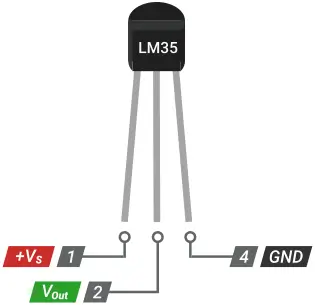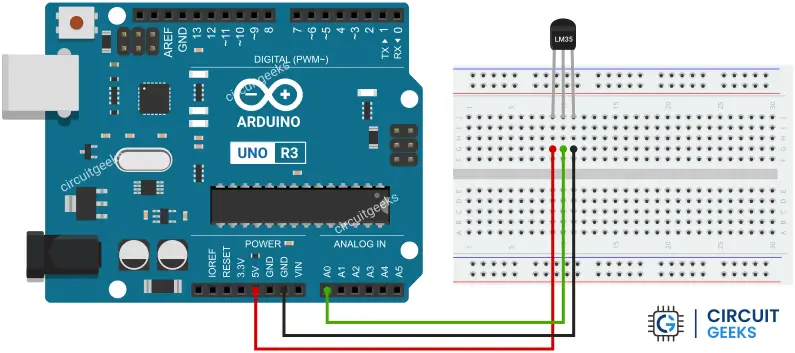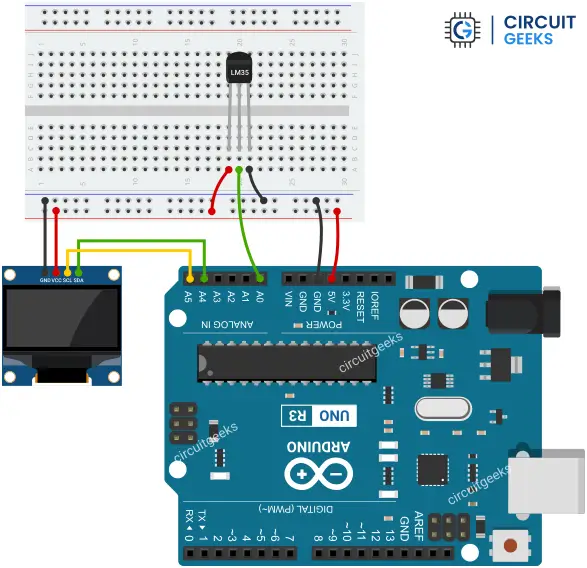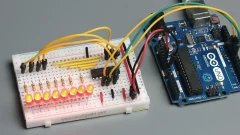The LM35 is a simple and precise analog temperature sensor that outputs a voltage directly proportional to temperature in degrees Celsius. It’s ideal for measuring temperature accurately with a simple setup.
In this tutorial, you will learn how to connect a LM35 temperature sensor to an Arduino and read the temperature data precisely. You will also learn how to display the temperature data on an I2C OLED display.
Table of Contents
LM35 Temperature Sensor
The LM35 is a linear temperature sensor that provides a voltage output directly proportional to the temperature in degrees Celsius. It operates on 4V to 30V, and draws less than 60 μA.
The LM35 is highly accurate and calibrated, offering ±0.5°C precision at room temperature (25°C) and ±0.75°C across its full -55°C to 150°C range. Also, it has low self-heating, only about 0.08°C in still air, which ensures that internal heat has no effect on the accuracy of temperature readings.

Although the LM35 is rated for -55°C to 150°C, measuring negative temperatures requires a negative voltage bias. For example, we can supply +5V to Vcc and -5V (instead of 0V) to GND, and the sensor will output voltages from -0.55V to +1.5V.
To read negative temperatures with an Arduino, you would need a level-shifting circuit using an op-amp. As the circuit is slightly complex, we will only focus on the 0°C to 150°C range in this example.
If you want to measure negative temperature without any complex circuit, use TMP36, LM335, or DS18B20 instead.
LM35 Pinout
It comes with a TO-92 package and an 8-pin dip package. The TO-92 package is most popular because it can be easily attached to any surface and used to measure the temperature of that surface.

| Pin | Descriptions |
|---|---|
| +Vs | Power supply pin (4V–30V). Connect to Arduino 5V. |
| Vout | Outputs analog voltage proportional to temperature. Connect to Arduino A0. |
| GND | Ground pin. Connect to Arduino GND. |
Arduino LM35 Circuit Diagram
Connecting the LM35 to an Arduino is very simple. Connect the VCC pin to the Arduino’s 5V pin and the GND pin to ground. Then, connect the Vout pin to any Arduino analog input pin; in this example, we’ll use A0.
Here’s how the circuit looks:

How to Calculate Temperature
The LM35 outputs 10 mV (or 0.01 V) for every degree Celsius. We can read the voltage at the Vout pin using the Arduino analog input pin. And from there, we can calculate the actual temperature.
Arduino Uno has 10-bit ADCs, which means analogRead() converts the input voltage range, 0 to 5 volts, to a digital value between 0 and 1023.
The general formula to convert the digital reading to voltage is:
\[V_{\text{out}} = \text{analogRead value} \times \left( \frac{\text{ADC reference voltage}}{2^{\text{[ADC resolution]}}} \right)\]
The Arduino Uno R3 board operates on +5V, and the resolution of the ADC pins is 10 bits.
\[V_{\text{out}} = \text{analogRead value} \times \left( \frac{5}{1024} \right)\]
The Arduino Uno R4 boards support 14-bit ADC.
\[V_{\text{out}} = \text{analogRead value} \times \left( \frac{5}{16,384} \right)\]
And for a 3.3V Arduino board with 10-bit ADC, we would do.
\[V_{\text{out}} = \text{analogRead value} \times \left( \frac{3.3}{1024} \right)\]
You can now easily read the Vout pins’ voltage on different Arduino boards and divide the voltage by 0.01 to obtain the temperature data in degrees Celsius.
Arduino Code for LM35 Temperature Sensor
You have learned how to read the voltage output from the Vout pin and get the temperature in degrees Celsius. Now, we will implement it using the Arduino code.
Arduino Code – View the Temperature in the Serial Monitor
// The LM35's Vout pin is connected to
#define LM35_PIN A0
void setup() {
// begin serial communication at 9600 baud rate
pinMode(LM35_PIN, INPUT);
Serial.begin(9600);
}
void loop() {
// reading voltage from the LM35 Vout
int val = analogRead(LM35_PIN);
// use 3.3 for 3.3v arduino
float voltage = val * (5.0 / 1024.0);
float tempC = voltage * 100;
Serial.print("Temperature: ");
Serial.print(tempC);
Serial.print("°C | ");
float tempF = (tempC * 9.0 / 5.0) + 32.0;
Serial.print(tempF);
Serial.println("°F");
delay(1000);
}Explaining the code
Here, you can see that we started by defining the Arduino pin connected to the sensor’s output pin. This pin must be an analog input pin, and we will use pin A0 for that.
#define LM35_PIN A0In the setup section, we declare this pin as an input pin.
pinMode(LM35_PIN, INPUT);We initialize the serial communication at a 9600 baud rate, as we use the serial monitor to view the data.
Serial.begin(9600);Now, coming to the loop section, we first read the analog pin value and store it in an integer variable.
int val = analogRead(LM35_PIN);Then we calculate the voltage.
float voltage = val * (5.0 / 1024.0);and multiply it by 100 to get the temperature in degrees Celsius.
float tempC = voltage * 100;Arduino Code with analogReference()
The default ADC step is 5/1024 = 4.88 mV. With analogReference(1.1V), the step size becomes 1.07 mV, meaning each step can detect smaller voltage changes.
LM35 gives 10 mV/°C (0–1.5 V for 0–150 °C). So 1.1 V ref covers 0–110 °C with ~0.1 °C resolution, much more accurate than the default 5 V ref.
Thus, using Arduino’s internal voltage reference improves the accuracy of LM35 temperature readings.
// Define the analog pin, the LM35's Vout pin is connected to
#define LM35_PIN A0
void setup() {
// Initialize serial communication
Serial.begin(9600);
// Use 1.1 V reference for ADC measurements
analogReference(INTERNAL);
}
void loop() {
// Get the voltage reading from the LM35
int val = analogRead(LM35_PIN);
// Convert that voltage into voltage
float voltage = val * 1.1 / 1024.0;
// Convert the voltage into the temperature in Celsius
float tempC = voltage * 100;
// Print the temperature in Celsius
Serial.print("Temperature: ");
Serial.print(tempC);
Serial.print("°C | ");
// Print the temperature in Fahrenheit
float tempF = (tempC * 9.0 / 5.0) + 32.0;
Serial.print(tempF);
Serial.println("°F");
delay(1000); // wait a second between readings
}LM35 with OLED Display
You have learned how to display the temperature on a serial monitor. Now, in this section, we will learn how to display the temperature on an OLED display.
If you are new to OLEDs, read the article below.
Circuit diagram
To add an I2C OLED to your existing circuit, connect its SCL pin to Arduino pin A5 (SCL) and its SDA pin to Arduino pin A4 (SDA). Then connect the OLED’s VCC and GND pins to the Arduino’s 5V and GND, respectively.

Arduino Code
The following code uses the u8g2 library by olikraus, so make sure to install it before compiling the code.
#include <Wire.h>
#include <U8g2lib.h>
// OLED Configuration
#define DISPLAY_WIDTH 128
#define DISPLAY_HEIGHT 64
#define DISPLAY_TYPE U8G2_R0 // Rotation (U8G2_R0: no rotation, U8G2_R2: 180 degrees)
U8G2_SSD1306_128X64_NONAME_F_HW_I2C oled(DISPLAY_TYPE, /* reset=*/U8X8_PIN_NONE);
#define LM35_PIN A0 // LM35 VOUT connected to A0
void setup() {
Serial.begin(9600);
pinMode(LM35_PIN, INPUT);
oled.begin(); // initialize the OLED
}
void loop() {
int val = analogRead(LM35_PIN);
float voltage = val * (5.0 / 1024.0);
float tempC = voltage * 100;
float tempF = (tempC * 9.0 / 5.0) + 32.0;
oled.clearBuffer(); // Clear internal buffer
oled.setFont(u8g2_font_7x14B_tf);
//
oled.setCursor(20, 16);
oled.print("LM35 Sensor");
// Celsius
oled.setCursor(0, 40);
oled.print("Temp(C): ");
oled.print(tempC, 1);
oled.print("\xb0"); // degree symbol
oled.print("C");
// Fahrenheit
oled.setCursor(0, 60);
oled.print("Temp(F): ");
oled.print(tempF, 1);
oled.print("\xb0");
oled.print("F");
oled.sendBuffer(); // Transfer buffer to the display
delay(1000);
}Summary
In this tutorial, you learned how to interface the LM35 temperature sensor with Arduino and display the readings on an OLED screen. We covered everything from understanding the sensor’s working principle to wiring, coding, and visualizing real-time temperature data.
Now that you can monitor temperature digitally, you can extend this project by adding data logging, wireless monitoring, or integrating it with a weather station setup.
If you enjoyed this tutorial, subscribe to our newsletter to get the latest Arduino and electronics tutorials delivered straight to your inbox!







